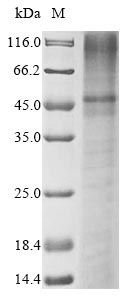This recombinant HumanKCNK3 protein is an in vitro E.coli (cell-free) expressed Full Length protein. Its purity is 85%+ determined by SDS-PAGE. Cell-free protein expression is the in vitro synthesis of a protein using translation-compatible extracts of whole cells. In principle, whole-cell extracts contain all the macromolecules and components needed for transcription, translation, and even post-translational modification. These components include RNA polymerase, regulatory protein factors, transcription factors, ribosomes, and tRNA. When supplemented with cofactors, nucleotides, and the specific gene template, these extracts can synthesize proteins of interest in a few hours.
KCNK3 is an acid-sensitive potassium channel responsible for the regulation of plasma membrane resting potential of human pulmonary artery smooth muscle cells (PASMCs). It mediates outward potassium ions current to counteract depolarization-induced calcium ions influx. Mutations in KCNK3 have been considered as a rare cause of both familial and idiopathic pulmonary arterial hypertension (PAH). The reduced KCNK3 activities caused by mutations probably lead to depolarization of the resting membrane potential, which could result in vasoconstriction and pulmonary artery remodeling. Besides, KCNK3 negatively modulates thermogenesis by inhibiting cAMP-PKA signaling.






